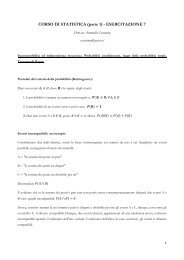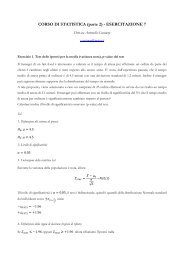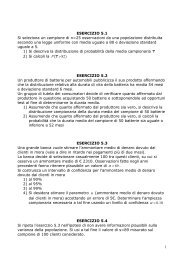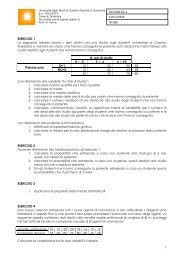moda, media e quantili per tabelle di frequenza
moda, media e quantili per tabelle di frequenza
moda, media e quantili per tabelle di frequenza
You also want an ePaper? Increase the reach of your titles
YUMPU automatically turns print PDFs into web optimized ePapers that Google loves.
Che corrisponde al seguente ragionamento in proporzione:<br />
<br />
<br />
<br />
− : − = − : − <br />
:<br />
− = − − <br />
− <br />
= + − − <br />
− <br />
à ù 21 è:<br />
=<br />
<br />
≡ + − <br />
− <br />
<br />
<br />
= 0 + + 0.45<br />
21 − 20 = 0.15 = 15%<br />
23 − 20<br />
Ulteriore approccio (derivato): e’ possibile ragionare in termini proporzionali <strong>di</strong>rettamente in tabella sul numero <strong>di</strong><br />
studenti che hanno un età al più pari a 21 (sfruttando le <strong>frequenza</strong> cumulate assolute associate alla classe che<br />
contiene il valore 21). E’ poi possibile risalire al valore <strong>per</strong>centuale con una semplice trasformazione del risultato.<br />
In particolare:<br />
valore noto=21 N(21)=?<br />
= 20 = 23<br />
= 0 = 9<br />
− : − = 21: 21 − <br />
9 − 0: 23 − 20 = 21: 21 − 20<br />
21 =<br />
9 ∗ 1<br />
3<br />
= 3<br />
F =?<br />
<br />
<br />
6








